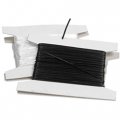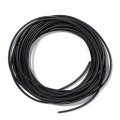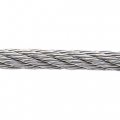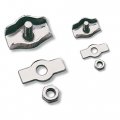Wire Ropes
Information about wire ropes
The maximum load capacity of synthetic fibre ropes has constantly increased over time but still falls short of ropes or cords made with steel wire; this accounts for the fact that steel wire ropes are still found being used as reliable hoist lines, lift lines or anchor lines. There are no synthetic fibre ropes that are as temperature and (UV) light resistant, none that are as abrasion resistance and resistant to stretching. It’s as simple as that.
These ropes consist of single strands of wire that are twisted together to form braids. These braids are then twisted together to form a rope. The numbers of strands and braids, as well as their arrangement in relation to one another, are what define a wire rope’s cross-section, i.e. the construction of the rope. The more individual wire strands that there are, the thinner each strand will be (at least with ropes of the same diameter) – this will also mean that the resultant rope will be generally suppler and more flexible and a smoother and more flat grooved surface will have been created.
A typical designation for a rope’s construction looks like this: 5 x 7 +1: this means that each braid consists of 7 wires and there are 5 braids twisted together to form the rope. The number following the “+” sign indicates how many wires make up the ropes core (the “soul” of the rope) around which the braids are wound.
The recommended maximum load capacity is determined by the Minimum Breaking Load (MBL) given by the manufacturer and the appropriate security factor (as determined by the intended use). The maximum load capacity given for our products is based on a security factor of 6. All the given weights are based on a nominal wire strength of 1770 N/mm².
In order to avoid having a rope fail to live up to its minimum breaking load value it must not be bent to too great a radius or, even worse, to the point of creasing. The minimum bending radius for a wire rope when making a loop at the rope’s end or when guiding the rope over a pulley is calculated as 18 times the diameter of the rope; for example, for a 2-millimetre rope the minimum radius would be 36 mm.
A wire rope cutter is recommended for cutting work; our Simplec wire rope clamp or other available type of clamps can be use for making loops at a wire rope’s end.







